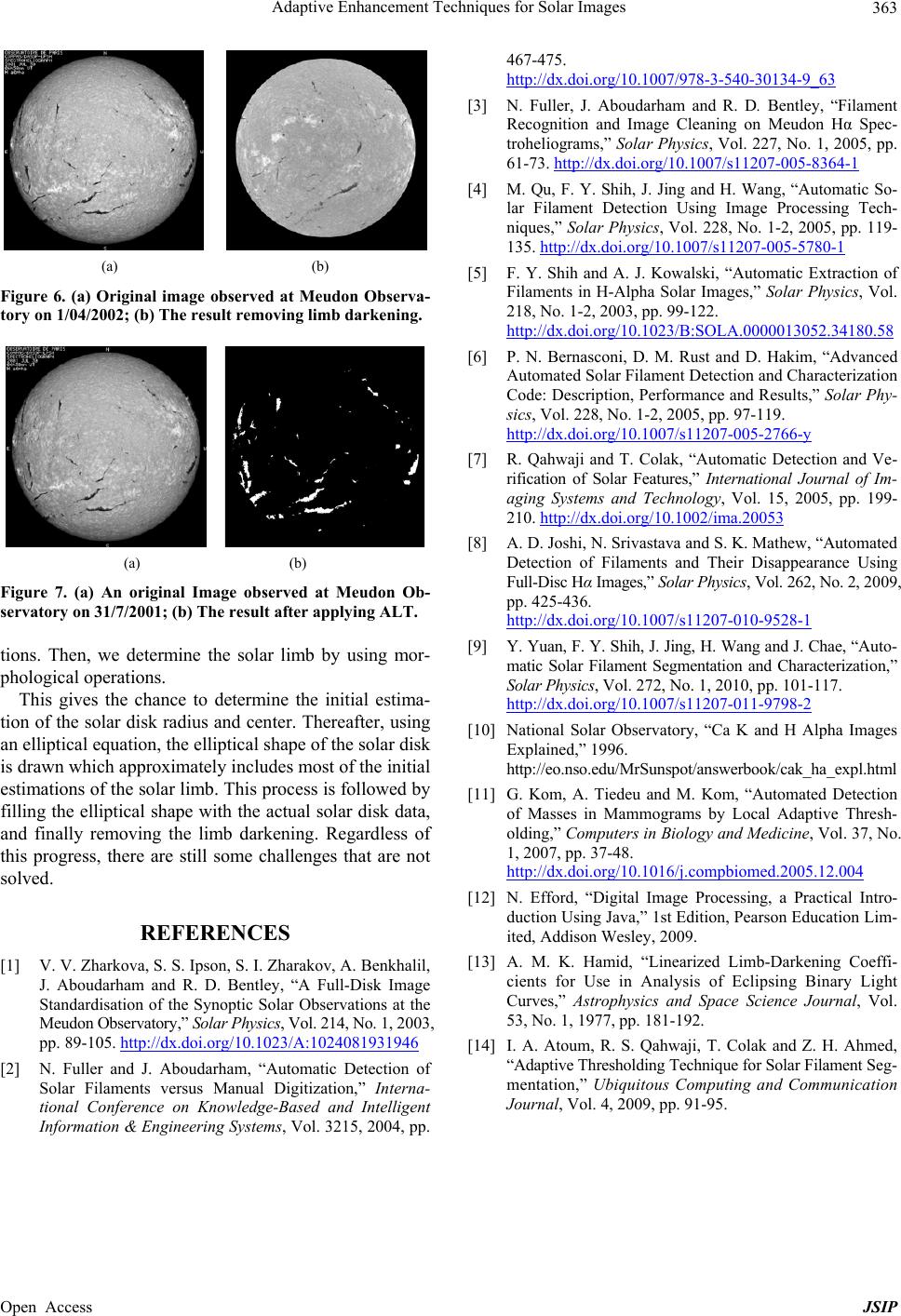
Adaptive Enhancement Techniques for Solar Images
Open Access JSIP
363
(a) (b)
Figure 6. (a) Original image observed at Meudon Observa-
tory on 1/04/2002; (b) The result removing limb darkening.
(a) (b)
Figure 7. (a) An original Image observed at Meudon Ob-
servatory on 31/7/2001; (b) The result after applying ALT.
tions. Then, we determine the solar limb by using mor-
phological operations.
This gives the chance to determine the initial estima-
tion of the solar disk radius and center. Thereafter, using
an elliptical equation, the elliptical shape of the solar disk
is drawn which approximately includes most of the initial
estimations of the solar limb. This process is followed by
filling the elliptical shape with the actual solar disk data,
and finally removing the limb darkening. Regardless of
this progress, there are still some challenges that are not
solved.
REFERENCES
[1] V. V. Zharkova, S. S. Ipson, S. I. Zharakov, A. Benkhalil,
J. Aboudarham and R. D. Bentley, “A Full-Disk Image
Standardisation of the Synoptic Solar Observations at the
Meudon Observatory,” Solar Physics, Vol. 214, No. 1, 2003,
pp. 89-105. http://dx.doi.org/10.1023/A:1024081931946
[2] N. Fuller and J. Aboudarham, “Automatic Detection of
Solar Filaments versus Manual Digitization,” Interna-
tional Conference on Knowledge-Based and Intelligent
Information & Engineering Systems, Vol. 3215, 2004, pp.
467-475.
http://dx.doi.org/10.1007/978-3-540-30134-9_63
[3] N. Fuller, J. Aboudarham and R. D. Bentley, “Filament
Recognition and Image Cleaning on Meudon Hα Spec-
troheliograms,” Solar Physics, Vol. 227, No. 1, 2005, pp.
61-73. http://dx.doi.org/10.1007/s11207-005-8364-1
[4] M. Qu, F. Y. Shih, J. Jing and H. Wang, “Automatic So-
lar Filament Detection Using Image Processing Tech-
niques,” Solar Physics, Vol. 228, No. 1-2, 2005, pp. 119-
135. http://dx.doi.org/10.1007/s11207-005-5780-1
[5] F. Y. Shih and A. J. Kowalski, “Automatic Extraction of
Filaments in H-Alpha Solar Images,” Solar Physics, Vol.
218, No. 1-2, 2003, pp. 99-122.
http://dx.doi.org/10.1023/B:SOLA.0000013052.34180.58
[6] P. N. Bernasconi, D. M. Rust and D. Hakim, “Advanced
Automated Solar Filament Detection and Characterization
Code: Description, Performance and Results,” Solar Phy-
sics, Vol. 228, No. 1-2, 2005, pp. 97-119.
http://dx.doi.org/10.1007/s11207-005-2766-y
[7] R. Qahwaji and T. Colak, “Automatic Detection and Ve-
rification of Solar Features,” International Journal of Im-
aging Systems and Technology, Vol. 15, 2005, pp. 199-
210. http://dx.doi.org/10.1002/ima.20053
[8] A. D. Joshi, N. Srivastava and S. K. Mathew, “Automated
Detection of Filaments and Their Disappearance Using
Full-Disc Hα Images,” Solar Physics, Vol. 262, No. 2, 2009,
pp. 425-436.
http://dx.doi.org/10.1007/s11207-010-9528-1
[9] Y. Yuan, F. Y. Shih, J. Jing, H. Wang and J. Chae, “Auto-
matic Solar Filament Segmentation and Characterization,”
Solar Physics, Vol. 272, No. 1, 2010, pp. 101-117.
http://dx.doi.org/10.1007/s11207-011-9798-2
[10] National Solar Observatory, “Ca K and H Alpha Images
Explained,” 1996.
http://eo.nso.edu/MrSunspot/answerbook/cak_ha_expl.html
[11] G. Kom, A. Tiedeu and M. Kom, “Automated Detection
of Masses in Mammograms by Local Adaptive Thresh-
olding,” Computers in Biology and Medicine, Vol. 37, No.
1, 2007, pp. 37-48.
http://dx.doi.org/10.1016/j.compbiomed.2005.12.004
[12] N. Efford, “Digital Image Processing, a Practical Intro-
duction Using Java,” 1st Edition, Pearson Education Lim-
ited, Addison Wesley, 2009.
[13] A. M. K. Hamid, “Linearized Limb-Darkening Coeffi-
cients for Use in Analysis of Eclipsing Binary Light
Curves,” Astrophysics and Space Science Journal, Vol.
53, No. 1, 1977, pp. 181-192.
[14] I. A. Atoum, R. S. Qahwaji, T. Colak and Z. H. Ahmed,
“Adaptive Thresholding Technique for Solar Filament Seg-
mentation,” Ubiquitous Computing and Communication
Journal, Vol. 4, 2009, pp. 91-95.